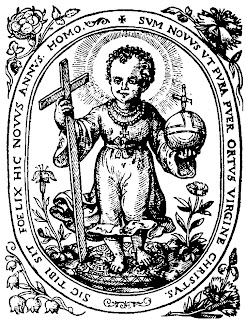This applies to the United States, where Works published prior to 1978 were copyright protected for a maximum of 75 years. See Circular 1 "COPYRIGHT BASICS" from the U.S. Copyright Office. Works published before 1923 are now in the public domain.
From the scanner: I, the copyright holder (Kenmayer) of this work, hereby release it into the public domain. This applies worldwide. In case this is not legally possible:
I grant anyone the right to use this work for any purpose, without any conditions, unless such conditions are required by law.
New Year's Day From Wikipedia, the free encyclopedia
New Year's Day is the first day of the year, in the Gregorian calendar, falling exactly one week after Christmas Day of the previous year. In modern times, it is January 1. In most countries, it is a holiday. It is a holy day to many of those who still use the Julian calendar, which includes followers of some of the Eastern Orthodox churches, and is celebrated on January 14 of the Gregorian calendar due to differences between the two calendars. It is usually celebrated with Fireworks,
March 15 in the old Roman Calendar, New Year's Day first came to be fixed at January 1 in 153 BC, when the two Roman consuls, after whom - in the Roman calendar - years were named and numbered, began to be chosen on that date, for military reasons. However in AD 525, Dionysius Exiguus set the start of the Julian calendar at March 25[citation needed] to commemorate the Annunciation of Jesus; a variety of Christian feast dates were used throughout the Middle Ages to mark the New Year, while calendars often continued to display the months in columns running from January to December in the Roman fashion.
Among the 7th century druidic pagans of Flanders and the Netherlands, it was the custom to exchange gifts at the New Year, a pagan custom deplored by Saint Eligius (died 659 or 660), who warned the Flemings and Dutchmen, "[Do not] make vetulas, [little figures of the Old Woman], little deer or iotticos or set tables [for the house-elf, compare Puck] at night or exchange New Year gifts or supply superfluous drinks [another Yule custom]." The quote is from the vita of Eligius written by his companion Ouen.
Most countries in Western Europe officially adopted January 1 as New Year's Day somewhat before they adopted the Gregorian calendar. This is sometimes called Circumcision Style, because this was the date of the Feast of the Circumcision, being the eighth day counting from 25 December.
This article is licensed under the GNU Free Documentation License. It uses material from the Wikipedia article, New Year's Day
Lt. Gen. James B. Peake (Ret.), M.D Biography and Coral snake (Micrurus fulvius tenere) and Fatigue effects in silicon














No comments:
Post a Comment